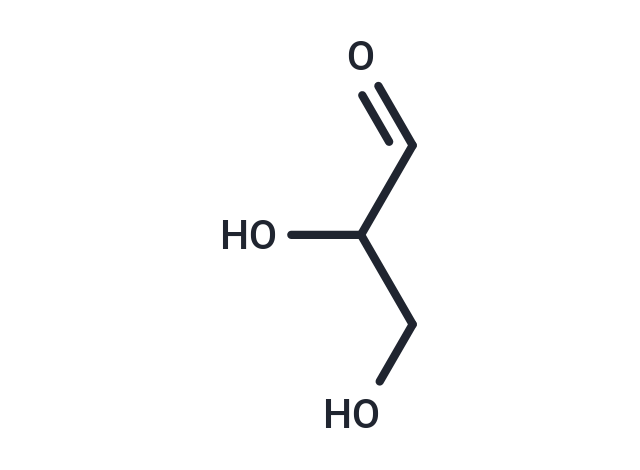- Remove All
 Your shopping cart is currently empty
Your shopping cart is currently empty
DL-Glyceraldehyde
DL-Glyceraldehyde (Glyceric aldehyde) is produced from the action of the enzyme glyceraldehyde dehydrogenase, which converts glycerol to glyceraldehyde using NADP as a cofactor. When present at sufficiently high levels, DL-Glyceraldehyde can be a cytotoxin and a mutagen. A cytotoxin is a compound that kills cells. A mutagen is a compound that causes mutations in DNA. DL-Glyceraldehyde is a highly reactive compound that can modify and cross-link proteins. DL-Glyceraldehyde modified proteins appear to be cytotoxic, depress intracellular glutathione levels, and induce reactive oxygen species (ROS) production (PMID: 14981296 ). DL-Glyceraldehyde has been shown to cause chromosome damage to human cells in culture and is mutagenic in the Ames bacterial test.

DL-Glyceraldehyde
| Pack Size | Price | Availability | Quantity |
|---|---|---|---|
| 10 mg | $47 | In Stock | |
| 25 mg | $76 | In Stock | |
| 50 mg | $112 | In Stock | |
| 100 mg | $165 | In Stock | |
| 200 mg | $245 | In Stock | |
| 1 mL x 10 mM (in DMSO) | $39 | In Stock |
Product Introduction
| Description | DL-Glyceraldehyde (Glyceric aldehyde) is produced from the action of the enzyme glyceraldehyde dehydrogenase, which converts glycerol to glyceraldehyde using NADP as a cofactor. When present at sufficiently high levels, DL-Glyceraldehyde can be a cytotoxin and a mutagen. A cytotoxin is a compound that kills cells. A mutagen is a compound that causes mutations in DNA. DL-Glyceraldehyde is a highly reactive compound that can modify and cross-link proteins. DL-Glyceraldehyde modified proteins appear to be cytotoxic, depress intracellular glutathione levels, and induce reactive oxygen species (ROS) production (PMID: 14981296 ). DL-Glyceraldehyde has been shown to cause chromosome damage to human cells in culture and is mutagenic in the Ames bacterial test. |
| Targets&IC50 | Aldose reductase:10 nM(Human) |
| Alias | Glyceric aldehyde |
| Molecular Weight | 90.08 |
| Formula | C3H6O3 |
| Cas No. | 56-82-6 |
| Relative Density. | 1.593 g/cm3 at -5℃ |
| Storage | Powder: -20°C for 3 years | In solvent: -80°C for 1 year | Shipping with blue ice. | |||||||||||||||||||||||||
| Solubility Information | DMSO: 4.4 mg/mL (48.85 mM), Sonication is recommended. | |||||||||||||||||||||||||
Solution Preparation Table | ||||||||||||||||||||||||||
DMSO
| ||||||||||||||||||||||||||
Sci Citations
Calculator
In Vivo Formulation Calculator (Clear solution)
Dose Conversion
Tech Support

Copyright © 2015-2025 TargetMol Chemicals Inc. All Rights Reserved.



